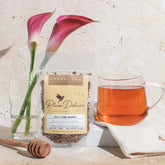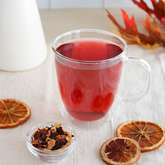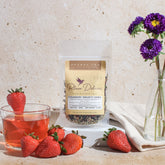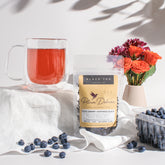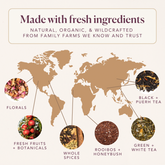Tea and wine, together at last. If tea and wine are your two favorite beverages, you can now have the best of both worlds with tea wine!
Whether you’re a red, white, or rosé drinker, whether you’re into Earl Grey or fruity herbals, we’ve got a tea wine recipe for you!

Why Tea Wine?
Infusions are such an easy process! You can infuse sugar, cream, liquor, and even honey—so why not try a wine infusion?
If you’ve ever had sangria, you’ve already experienced the beauty of infused wine. Sangria is basically just fruit-infused wine, sometimes with added booze or bubbles.
Tea wine is even easier than sangria! Simply combine your favorite tea with a glass or bottle of wine, let some time pass, and it’s smooth sipping ahead!

White Tea Wines
White wines are a summer favorite! Crisp, light, refreshing…whether you’re enjoying a melon peach sangria with fruit fresh from your farmer’s market, sipping a sparkling elderflower sangria in your garden, or relaxing with a boozy Arnold Palmer-inspired wine cocktail on your front porch, white wine is always satisfying during those hot summer months!
When experimenting with your tea wine recipe, you can either start with your tea or your wine as the base.
Do you like a light Pinot Grigio or an herbaceous Sauvignon Blanc? How about a zesty Chenin Blanc or tropical Albariño?
Choose a tea that will complement the overall flavor profile of your wine. If your Albariño has notes of exotic fruits, maybe select a blend that will lean into those flavors, like Pineapple Pop with its mélange of pineapple, mango, apricot, and orange peel.
If you’re more interested in a wine with hints of mellow stone fruit, like Chenin Blanc or a Marsanne blend, consider Peach Bellini herbal tea. The peach essence will pair perfectly, while the pineapple, strawberry, and mango pieces add delicious contrast and dimension.
If you like a mouth-wateringly acidic wine, butterfly pea flower tea is always a fun pairing! The beautiful blue pigment in the pea flowers turns a gorgeous purple when combined with high-acid liquids, for a wine cocktail that is truly stunning! And with its sweet cornucopia of fruits and florals (including strawberries, raspberries, hibiscus, rosehips, and lemongrass, to name just a few), Magical Butterfly tea is a delightful, dynamic choice to pair with just about any white wine!
Similarly, if you know what kind of tea you like, you can always tailor your wine choice to match your tea taste.
If you like a complex, floral herbal tea like Vista Blend or Calm Chamomile Bloom, you might match it with a creamy Viognier.
If you like a nice citrusy zing to your tea, like Good Morning Moringa, with its triple threat of lemongrass, lemon peel, and lemon essence (softened, of course, by a sprinkling of date and tangerine pieces), a zippy Sauvignon Blanc or tart Albariño might be just your cup of tea wine!
Choose either your favorite tea or your favorite wine (or both!), let the flavors meld, and enjoy your tea wine.

Red Tea Wines
There is a huge spectrum of body and flavor in the world of red wine. From a fruit-forward Pinot Noir to a juicy Cabernet Sauvignon, to an earthy Syrah, the red wine you choose will have a huge impact on the outcome of your tea wine.
Maybe you already know what type of red you prefer. (I love a velvety Merlot, a spicy Mourvèdre, or a tannic Tempranillo, while I tend to steer clear of any meaty Petit Verdot and herbaceous Cabernet Franc.)
However, if you’re looking for some direction for a good red summer tea wine, you might choose something on the lighter end of the spectrum.
In summer, I tend to gravitate toward lighter-bodied reds like Pinot Noir, Grenache, Carménère, or Gamay. (Although this Fireside Chat with a smoky Syrah might just be mind-blowing. Again, if you know your palate and you like a deep, bold red, do what makes you happy.)
So what tea do you choose for your red tea wine?
For whites and rosés, herbal teas and green teas are less likely to overpower the flavors, but reds are generally able to stand up to the more robust body of black teas. That really opens up a world of possibilities for your tea infusion!
You might try a soothing Earl Grey or a spicy Chai.
Maybe you lean into a fruity flavor profile with strawberry, cherry, or plum.
A delicate jasmine tea could bring out the floral notes in your Pinot Noir or Carménère.
If you’re concerned about mixing a high caffeine tea with alcohol, stick with a white tea or an herbal.
A note about making red tea wine: There’s a lot to be said for letting your wine breathe, but if you leave wine sitting out for too long, it will over-oxidize and start to taste like vinegar. White wines and rosés are less at risk because they store well in the fridge, but reds are most commonly served at room temperature.
There are a couple of different tea-infusing methods to avoid over-oxidizing your wine.
Similar to a white or rosé, you can cold brew in the fridge for as little as four hours, or even overnight. (Though keep in mind, red wines don’t always last well overnight unless you pump the air out of the bottle to keep them fresh. Wine pumps are easy to find and often as little as ten dollars.)
You could also bring your wine to a simmer on the stove and add your loose leaf tea, allowing it to steep around three to five minutes before straining and letting your wine cool. Once the drink comes back to room temperature, it will be ready to enjoy!
My preferred method is to steep the leaves in the wine at room temperature for about two hours. It gives the leaves enough time to impart flavor as the wine breathes, without letting the wine sit for so long that it starts to take on a vinegary taste.
As with the white tea wine, choose both a wine and a tea that you like, and see what fun combinations you can create!
Does it pass the sniff test? Oftentimes, if I’m not sure whether I want to combine two flavors, I’ll put them together and smell them to see whether I like the combined scent. Since the nose on both wine and tea is often an indication of how it will taste, try smelling them at the same time before you start your infusion. It can’t hurt!
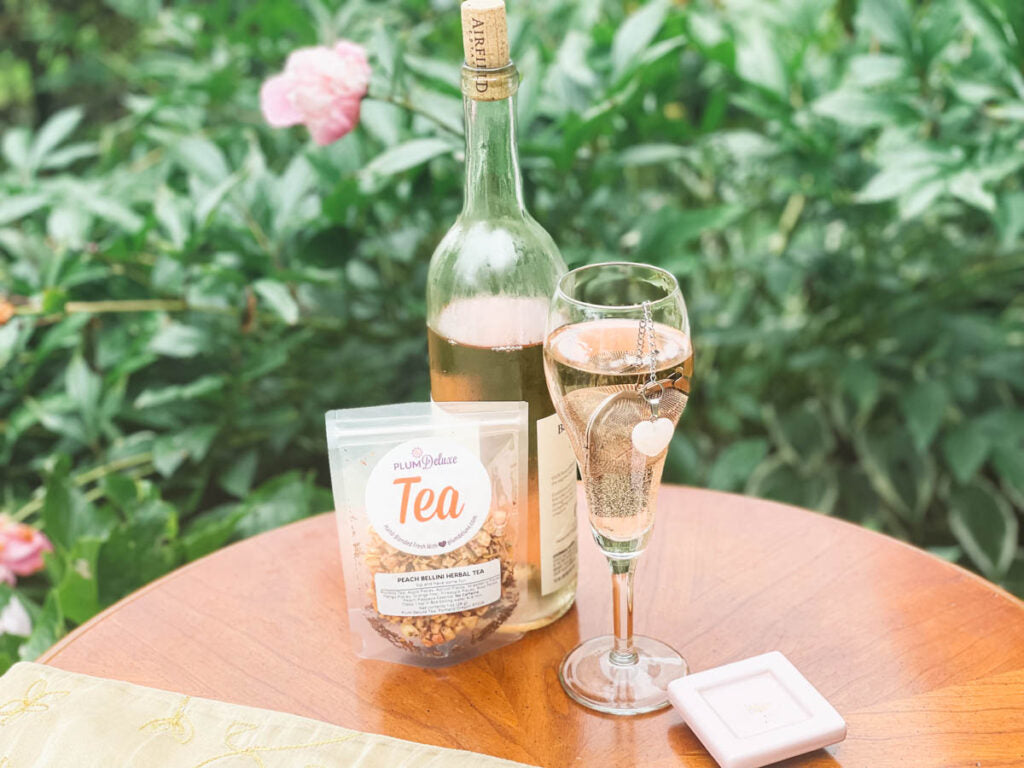
Rosé Tea Wines
When the temperature hits a certain point, some people just want rosé all day!
If that’s your thing, raid your tea cupboard, pop open a bottle of your favorite pink wine and sip your cares away!
Rosé lends itself well to pairing with light, luscious, fruity teas. (Which is why rosé sangrias are so delicious) Try your rosé tea wine with Strawberry Immunity herbal blend—a delicious fruit bomb of a tea that has bonus immunity-boosting properties!
Or maybe the more tropical Dragonfruit Desire or Pineapple Pop could play up the flavors in your wine!
Something with a bit more zip like the Just Hibiscus or the Self Care blend with elderberry and apricot could be a lovely addition to a low-acidity rosé that could use a little extra punch.
I’m always a fan of floral wines and floral teas, so my perfect pairing might be Evening in the Garden (which I already know makes an absolutely stellar cocktail and sangria, so how can it go wrong with tea wine?). The elegant blend of elderflower, rose, lemon, and vanilla would be a beautiful accompaniment to perfectly chilled rosé.
Of course, many people love a sparkling rosé.
Sparkling wines can be tricky to infuse because they lose carbonation during the steeping process. You can always try your luck turning your favorite sparkling into a tea wine (and even give it a little stir or shake to reinvigorate those bubbles after the tea has steeped), but don’t be too disappointed if the fizz fades post-infusion.
For any fans of the Frozé (rosé slushie), another fun way to incorporate your tea with your wine is to make ice cubes out of your tea, then blend them with your wine! Nothing is diluted from boring old ice cubes made from water—it’s just pure tea and wine flavor!
And if you can’t get enough rosé, check out this bubbly jasmine tea sangria with cherries, peaches, and vanilla; or this Sunset Sangria with kiwis, plums, and strawberry!
When you’re ready to make your tea wine, pick out a bottle of wine that looks good, see what’s in your tea cupboard, and choose the one you think will have the most complementary flavors. Tea wine is a super simple concept, so don’t stress! Two delicious drinks are sure to combine into something new and equally delicious.

Blueberry Hibiscus Red Tea Wine
- 1 bottle (or 8 oz) pinot noir or red wine of choice
- 1 and 1/2 tablespoon (or 1 teaspoon) Easy to Be green tea or tea of choice
Combine tea leaves and wine.
Let sit at room temperature for about two hours.* (Or longer in the refrigerator, even until the next day. If storing overnight, be aware the wine may become overly oxidized.)
Strain leaves from wine, and enjoy!
*Alternatively, you could simmer your wine on the stove top and add your leaves, steeping for three to 5 minutes before straining out the leaves. Let the wine cool to room temperature and enjoy!
Pineapple Pop White Tea Wine
- 1 bottle (or 8 ounces) Pinot Grigio or Sauvignon Blanc or white wine of choice
- 1 and 1/2 tablespoon (or 1 teaspoon) Pineapple Pop herbal tea or tea of choice
Combine tea leaves and wine.
Let steep in the refrigerator at least 4 hours, or overnight.
Strain leaves from wine, and enjoy!
Sparkling Peach Rose Tea Wine
- 1 bottle (or 8 ounces) rosé
- 1 and 1/2 tablespoon (or 1 teaspoon) Peach Bellini herbal tea or tea of choice
- 2 cups (or about 3 ounces) lemon sparkling water or sparkling water of choice
Combine tea leaves and wine.
Let steep in the refrigerator at least 4 hours, or overnight.
Strain leaves from wine. Top with sparkling water.
Serve and enjoy!
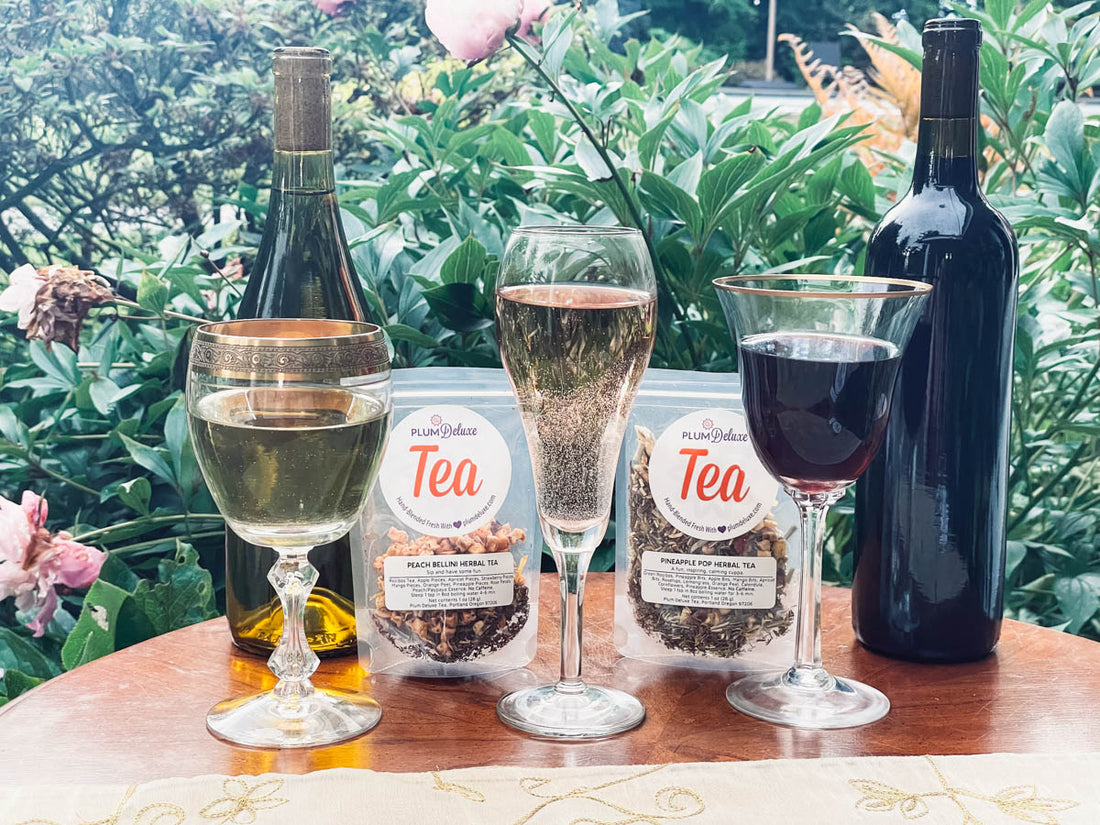
![Fall Tea Variety Pack [6-Pack Variety of Flavors]](http://www.plumdeluxe.com/cdn/shop/files/Fall_Tea_Variety_Pack.png?v=1754953749&width=165)


